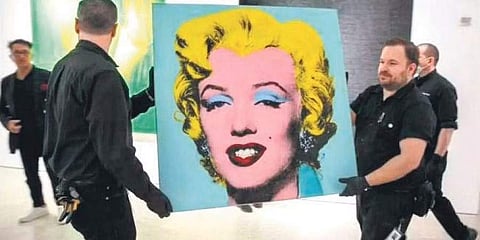
- LIFESTYLE
- FASHION
- FOOD
- ENTERTAINMENT
- EVENTS
- CULTURE
- VIDEOS
- WEB STORIES
- GALLERIES
- GADGETS
- CAR & BIKE
- SOCIETY
- TRAVEL
- NORTH EAST
- INDULGE CONNECT

In the middle of May, Andy Warhol’s portrait of Marilyn Monroe, ‘Shot Sage Blue Marilyn’, went for $195 million. It is the most expensive 20th-century artwork to be sold at auction. The buyer? Unknown. Who dropped over $1 million for a work of “invisible art” at Sotheby’s in April? Unknown.
A 1961 oil painting by VS Gaitonde fetched `39.98 crores at a Mumbai auction in March last year, making it the most expensive work by an Indian artist. The second spot was quickly snapped up a few months later by Amrita Sher-Gil’s ‘In Ladies Enclosure’ (1938) that sold for `37.8 crores at another sale. Buyers? Nameless.
Who bought Picasso’s ‘La Dormeuse’ for $57.8 million?
Since the turn of the 21st century, the contemporary art market is rolling in dough. New artists, new mediums, and new innovations have sent its monetary velocity into high gear. The identities of most buyers are never disclosed by auction houses and galleries––the price of disclosure is too high. Names will be disclosed only if the buyer gives the go-ahead. An anonymous buyer can, for a price, keep his name away internally.
Why do buyers, unless they are crime lords or dirty politicians, wish to remain nameless? Privacy is one. Some collectors dislike public attention. “Collecting art is a very niche practice. Collectors often choose to remain anonymous as they value their privacy. They generally tend to only share their art collection with a select group of people. This trend is consistent across the board irrespective of the value of the artwork,” says Sneha Gautam, Vice President-Client Relations, AstaGuru. The Delhi-based auction house, in December last year, sold a 1987 work by Tyeb Mehta for `24.27 crores, its most expensive sale yet.
Then there is plain vanity, the power that comes from keeping the world breathless to know how much money was actually spent—the wealthy classes know the power of gossip, which the art world has an abundance of. Sometimes a collector who is mopping up the works of a specific artist prefers to stay anonymous for fear of tipping off the competition and raising prices. Then there are privacy-obsessed buyers who do not wish to personally attend auctions. They ask a reputed dealer to bid for them—Larry Gagosian bid for the Warhol on behalf of a faceless collector.
The pact between a buyer and dealer is almost sacred since only the very rich participate in big sales. Some bids are on the phone, carried out by their relationship specialists at the auction house. “Loose lips sink ships. Those who don’t know talk and those who talk don’t know” is the motto of an art advisor to millionaires who prefer to stay anonymous. Complications could arise in such situations. Most auction houses don’t know who owns the art they are selling. According to the New York Times, the auction house does not get a cent from the sale of a painting. Their commission is from the seller who is an intermediary.
Indrajit Chatterjee, Director, Mumbai-based auction house Prinseps, insists that there “isn’t anything nefarious or sinister” about the anonymity. “Art is something that you keep inside your house... it’s a personal possession. And you are more private about your personal possessions. It’s as simple as that,” he says, adding, “The auction house and tax authorities are aware of the buyer’s identity because buyers have to pay GST.”
Some governments are concerned about criminals investing in art to launder money. How do they do it? Art is one of the most easily portable commodities compared to bullion in this highly unregulated market. Paintings and sculptures require only minimal paperwork done in private. Someone who has, for example, $100 million in undeclared funds, will start by buying, say, a Raza or an Ed Ruscha in Hong Kong, and immediately store it at a “freeport” that allows tariff-free imports of goods that are taxable only if they are sold in the domestic market. The shadowy buyers can also move the art into a high-security storage space near the airport. An anonymous buyer will purchase the painting and retrieve it from the same freeport. This way, the original buyer has made money from a legit deal.
According to The Economist, in 2013 the Geneva freeport which is also a tax haven has $100 billion worth of US art sitting pretty awaiting buyers. Terrorists make big-time money launderers of looted art. They sell stolen objects of value to freelance middlemen who smuggle them out of Syria or Iraq into neighboring Lebanon and Turkey from where they are transported via a secret art smuggling line to shady Europe warehouses where Western buyers snap them up. A notorious case was the Oklahoma City-based retail giant Hobby Lobby buying Iraqi artifacts for the Museum of the Bible—they were returned after the US turned on the heat.
A famous case happened in 2015 when Sotheby’s sold a Toulouse-Lautrec for $16 million. Since the buyer––a nameless Russian billionaire––had authorised his advisor to do the paperwork claiming ownership, it was the advisor who received the check. After a legal battle, it was found that the billionaire “used offshore shell companies that obscured his ownership of art”. In 2019-20, the EU implemented the fifth Anti-Money Laundering Directive, particularly in the UK, as the first step to regulating the international art market.
The NFL decade has produced a new breed of anonymous buyers who first splurge cryptocurrency at auctions only to re-veal their identities later—a new version of the ego trip. Their purpose is to impress the younger artists and burnish their credentials as collectors. The practice is, however, frowned upon in traditional art circles where discretion is the better part of an auction.